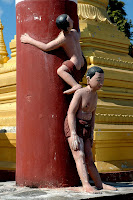by Jim Goodman
Visitors to Mandalay arrange their itineraries around visits to Myanmar’s former royal cities. They tour the temples and historic ruins of Inwa, Amarapura, Sagaing and Mandalay itself, the last of the nation’s royal capitals before the British terminated the institution. Yet not far away, around six hours by car to the northeast, lies another former royal capital, Shan not Burmese, known as Hsipaw by its Shan inhabitants and Thibaw by the Burmese. It was once an autonomous state of its own, ruled by its own saopha, one of many such little princely realms that were eventually consolidated into the single political unit now known as Shan State.
 |
| Hsipaw lies on the banks of the Dokhtawaddy River |
The town itself feels like a true farmers’ city. Other than an old cinema, there are no entertainment venues and the streets are nearly empty by nine p.m. Farmers fill the morning market along the Dokhtawaddy River long before dawn, while activity in the town’s central market starts tapering off by eight a.m. Bullock carts ramble through the streets as often as cars. No one appears to be in any kind of hurry. And all the women seem to carry their goods on their heads.
 |
| a common sight on the streets of Hsipaw |
Some years later a succession struggle broke out in Hsipaw and Paw Pan usurped the throne without securing the customary approval of the Mong Mao saopha. The latter’s son subsequently led an army against Hsipaw and Paw Pan capitulated at once. The victor then had Paw Pan, his family, followers, horses and elephants all massacred together at a site called Tong Suat. A temple and shrine then went up over the spot, now about two kilometers northwest of the town, and Paw Pan was declared Hsipaw’s official guardian spirit. Whether Paw Pan was informed of his ultimate post-mortem role before he was killed is not known.
Centuries later, with the rise to power of Bayinnaung, Burma once again had a strong and ambitious king. After uniting the vassal states along the Ayeyarwadi River, Bayinnaung then launched a campaign against Siam. The state of Hsipaw supplied the elephants and the cavalry for the invasion force. In 1569 Ayutthya fell and among the treasures seized in the conquest were a number of ancient Khmer bronzes, which Thai armies had looted from Angkor when they sacked that city in 1431. When he returned to his own capital Bayinnaung passed through Hsipaw. In a farewell ceremony at Bagyo Paya, the king donated three of the bronzes to his Shan ally, which the saopha had installed in a separate shrine still standing in the pagoda’s courtyard.
 |
| Bagyo Paya temple |
Despite its antiquity, though, its beautiful modern embellishments tend to impinge upon its historical atmosphere. But for authentic ruins and relics of Hsipaw’s past glory, one needs to go outside the northern end of the town, turning west past the shrine to Paw Pan, to the quiet and evocative site known locally as Little Bagan. This is an area around the 150 year-old stilted wooden monastery of Mahananda Kantha, comprising several groups of even older chedis, some whitewashed, some plain brick, that date back to the time Hsipaw was located here, 4 km northwest of the town center today.
 |
| stupas in "Little Bagan" |
 |
| pillar at Mahamatyamuni Temple |
Until they left after 1948, the British brought the accoutrements of colonialism to Hsipaw, elements which have now become absorbed into the town’s contemporary character. Thus, Hsipaw, like so many other Burmese towns and cities, also has a clock tower, symbolizing the British attempt to make their subjects aware of the passage of time, when prior to their arrival it did not matter so much. Besides the magnificent Mahamatyamuni Temple the town has several other Buddhist pagodas, both within the town, on its outskirts, and on the hills around it. But now it also has a big mosque, Hindu temples, Christian churches and a Chinese Mahayana temple, all of which still serve the religions of the communities brought in by imperialism.
 |
| colonial era buildings |
 |
| Hsipaw's clock tower |
As a typical small city in a very underdeveloped country, Hsipaw also boasts the unusual attraction of old-fashioned small factories that provide a few more interesting distractions for those coming from the advanced countries of the West (and for that matter most of Southeast Asia). Visitors can watch the production of noodles, popcorn, sandals and cheroots. With boat trips and day-treks available, hilltop temples with great views of the city and its surroundings constantly beckoning, fine-looking buildings, good food and a friendly local population, it’s no wonder that nearly every visitor to Hsipaw adds another day or two to the original amount of time intended to explore this fascinating Shan destination.
 |
| the ruins of "Little Bagan" on Hsipaw's original site |
* * *








